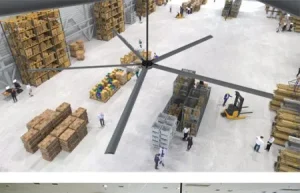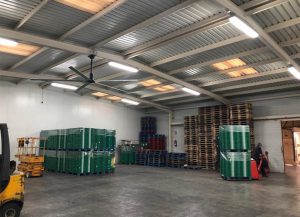Crowded, overheated indoor spaces reduce comfort, disrupt productivity, and spike energy costs. Conventional fans often fail to eliminate stagnant air, causing uncomfortable drafts or stuffy corners. The solution? Embrace the transformative power of a HVLS fan—a high-volume, low-speed system engineered to cover large open areas seamlessly.
A HVLS fan (High-Volume, Low-Speed) typically spans anywhere from 8 feet to 24 feet in diameter, significantly larger than a standard ceiling fan. These big fans revolve slowly but move large amounts of air across large open spaces, like warehouses or gyms. By distributing air gently, they maintain consistent temperatures, curb energy consumption, and enhance occupant comfort. Such fan size ensures broad coverage, reducing the need for multiple smaller fans. As a result, HVLS fans facilitate better airflow while minimizing noise and energy demands.

HVLS Fan Size Demonstration
Before delving into how big a hvls fan truly is, let’s define the concept. The acronym stands for “High Volume Low Speed,” describing large overhead fans that move large amounts of air at a low speed. Unlike smaller fans spinning fast to create a breeze, HVLS solutions spread air gradually but extensively.
From factories to school gyms, these fans provide broad-based cooling and ventilation. They help maintain occupant productivity, reduce reliance on hvac systems, and handle airflow demands in expansive settings. Because they revolve slowly, they minimize wind turbulence or annoying wind tunnels—offering a balanced environment instead of localized blasts.
Case Insight: Our HVLS fans at hvls fans Manufacturing have aided many businesses—factories, commercial buildings, and sports centers—in significantly upgrading occupant comfort while securing reduced energy costs.
Fan size heavily impacts coverage. A tiny ceiling fan might handle a small office, but for a warehouse or sports center, you need a fan measuring multiple feet in diameter. So, let’s explore how size shapes air movement.
Choosing the right size can transform occupant comfort. Too large, and you might overshoot your coverage needs or run into overhead obstructions. Too small, and the fan isn’t able to unify the environment’s climate effectively.
A typical ceiling fan used in homes might measure 52–60 inches. By contrast, HVLS solutions can measure up to 24 feet. That difference is enormous in terms of potential coverage. A single HVLS might replace multiple smaller fans in a sizable facility, simplifying overhead clutter.
Tip: Looking to recirculate air in a 20,000-square-foot warehouse? A single one 24’ fan can often do the job of 8–10 standard “industrial” fans, boosting occupant comfort while lowering overall power consumption.
When determining ceiling fan or HVLS size, you consider:
HVLS fans worth their investment typically incorporate advanced guidelines to decide the right hvls ceiling fan size. By analyzing occupant density, air circulation demands, and potential obstructions (lighting, sprinklers), you pinpoint the ideal diameter.
| Space Size | Recommended HVLS Fan Size | Typical Coverage |
|---|---|---|
| Under 3,000 sq ft | 8–10 ft diameter | Smaller shops, large rooms |
| 3,000–8,000 sq ft | 12–16 ft diameter | Mid-scale gym, small warehouse |
| 8,000–20,000 sq ft | 16–20 ft diameter | Large open areas, factories |
| 20,000+ sq ft | 20–24 ft diameter | Expansive distribution centers |
Ceiling fan sizing for an HVLS solution hinges on these data points. An undersized fan struggles to unify temperatures, whereas an oversized unit can cause air movement issues if placed improperly.

HVLS Fan in a small warehouse
When people think of extremely large overhead fans, they sometimes recall the brand “big ass fans” or “big ass fans®.** This brand identity gained popularity for massive, high-diameter solutions suitable for industrial or commercial environments. Whether you pick a Big Ass Fans® product or from other manufacturers, the fundamental principle remains: a big diameter equals broad coverage.
Though “big ass” is often used colloquially for large fans, it specifically references a brand recognized for oversize diameter. Indeed, hvls fan solutions from them range up to 24 feet, aligning with the typical HVLS approach. Meanwhile, many other providers, including our hvls fans Manufacturing facility, produce comparable large-scale overhead fans that measure in the feet to 24 feet range.
HVLS ceiling fans offer a gentler breeze than high-speed small fans. While big ass fans revolve slowly, they push massive volumes of air, ensuring occupant comfort without unpleasant gusts. Industrial ceiling fan models from various suppliers incorporate the same principle—diameter is everything.
Case: A distribution center replaced multiple standard overhead fans with one 22-foot HVLS from a “big brand.” The uniform air circulation drastically improved employee satisfaction and air quality, proving the efficacy of a single large-diameter HVLS solution.
An HVLS might carry a higher initial cost than smaller fans. However, the potential for reduced energy costs is substantial. By circulating air gently, an HVLS can help your HVAC system operate more efficiently. The fan effectively recirculates warm air in winter or helps keep the environment comfortably cool in summer, lessening the load on air conditioning.
Fans also demand minimal energy to rotate at low speed. Because they have large fan blade surfaces, they don’t need high RPM to produce the same air movement smaller fans might struggle to achieve. This synergy fosters both occupant comfort and relief on the cost side.
If you run a warehouse storing temperature-sensitive goods or a bustling gym, occupant or product well-being can benefit from consistent cooling. The result is fewer hot spots, less equipment overheating, and potentially longer product lifespans. For managers and owners, these intangible gains, combined with direct energy efficiency savings, prove that HVLS solutions are often a wise, long-term investment.
Expert Opinion: “HVLS fans operate at minimal watt draw, distributing air effectively with fewer units than smaller fans. This approach is vital for commercial spaces wanting to slash overhead and maintain comfortable conditions,” says a facility manager of a major sports center.
How big can an HVLS fan get?
Typically, HVLS fans range in diameter from about 8 feet to 24 feet. Some specialized units can exceed that diameter for very large or specialty environments.
What is the right size HVLS fan for a 10,000-square-foot space?
In general, a 16–18 ft hvls ceiling fan suits mid-scale spaces around that size. The size of the space, ceiling height, and occupant density influence final sizing. We can help you get the right fan by factoring your square footage.
Are Big Ass Fans® the only large HVLS solutions?
No, multiple manufacturers (including ours) produce high-quality fans for large industrial or commercial sites. big ass fans is a well-known brand, but HVLS technology is widely adopted across many suppliers.
Do smaller fans help in a large environment?
They can, but you’ll need multiple smaller fans to match the coverage of a single HVLS unit. That can lead to higher energy consumption and more overhead clutter. Often, a single HVLS better meets your coverage and cost goals.
Which industries benefit the most from HVLS?
Spaces like warehouses, gyms, schools, sports centers, large barn setups, and manufacturing plants typically get the biggest payoff. The technology is ideal for industrial and commercial usage where wide footprints need stable air circulation.
A smaller, high-speed fan must spin at hundreds of RPM to generate noticeable breezes. By contrast, an HVLS at low speed can harness a broad fan blade sweep, moving the same or greater volume of air but distributing it more evenly. This design fosters consistent air movement that’s free of intense, localized gusts.
Fans are designed for minimal noise and occupant disruption. In places like fitness centers or large retail shops, you want thorough coverage without feeling hammered by a strong wind. HVLS solutions accomplish precisely that.
While HVLS fans don’t lower the actual temperature, they create a “cooling effect” by accelerating sweat evaporation and air mixing. Occupants feel cooler by 4–8 degrees Fahrenheit—enough to reduce the load on AC or maintain a more comfortable environment in non-AC spaces.
Mechanic: HVLS fans rotate at a low rotational speed, distributing fresh or cooled air gently, which merges seamlessly with HVAC if present. This synergy fosters consistent occupant comfort.
When installing a large hvls ceiling fan, your mounting height typically must meet certain guidelines—like maintaining at least 10–12 feet from the blade to the floor. This ensures ample clearance for occupant safety and effective air circulation. In extremely tall ceilings, extension rods can lower the fan to an ideal position for maximizing coverage.
Ceiling fan must be placed centrally or in strategic zones to unify airflow throughout your space. In a 20,000 sq. ft. distribution center, for instance, you might situate one or two HVLS fans in symmetrical positions, ensuring no corner remains stagnant.
Industrial ceiling fan or HVLS solutions sometimes weigh over a hundred pounds. Confirm the structural overhead can handle the load. Evaluate joists, beams, or rafter design. If in doubt, consult an engineer or check brand guidelines. This ensures your big fan remains stable, avoiding potential vibrations or mechanical stress.
Pro Tip: Many industrial sites harness hvls fan solutions at 20–30 feet overhead. This vantage point fosters even distribution, letting the gentle breeze descend gradually from top to bottom.
Installing a Big HVLS Fan
HVLS fans do more than just push air in warm months. By reversing direction or simply distributing layered hot air near the ceiling, they help in heating and cooling year-round. The principle: hot air rises, so the upper portion of a building can store heated air that’s effectively wasted if not circulated downward.
During winter, HVLS fans revolve (sometimes in reverse) at a slow pace, gently pushing the hot air at ceiling level down to occupant height. This approach relieves your furnace workload, balancing temperature so you don’t keep blasting heat for the occupant zone.
In warm seasons, the fan rotates in a forward orientation. The broad, gentle airflow keeps occupants comfortable without forcing you to overrun AC. Because these fans spread air widely, they reduce or eliminate hot pockets, especially near machinery or corners.
Savings: Some sources note that HVLS usage in winter can lead to a 20–30% cut in heating costs by recirculating trapped heat. Meanwhile, summer usage can offset AC demands significantly.
In commercial spaces—like large retail stores, showrooms, or conference halls—HVLS fans excel at controlling air conditions. Whether you want to reduce occupant discomfort or maintain stable inventory climates, a hvls fan can unify temperature layers. This synergy is especially beneficial if your building hosts frequent foot traffic, reducing the risk of overheated customers or staff.
HVLS fans provide a gentle breeze across open floor plans. By letting visitors or staff feel a cooling effect, you reduce stuffiness, keep them engaged, and possibly extend the time they remain on-site. Many commercial managers also note fewer AC breakdowns once HVLS fans are integrated since the AC doesn’t run as hard.
Fans help in other ways, too—like curbing moisture, preventing stagnant air, and limiting condensation. With better airflow, surfaces remain dry, mitigating slip hazards in large entrance lobbies or sporting complexes.
Case: A major retailer installed a 20-ft HVLS in the center of their 30,000 sq. ft. store, slashing overhead air conditioning usage, improving customer comfort, and receiving positive feedback from staff about the more consistent environment.
Which fan size suits my 15,000 sq. ft. warehouse?
Typically, a 16–20 ft hvls ceiling fan works well for mid to large areas. However, fans need to factor in ceiling height, open obstructions, and occupant density. We can help you make informed decisions for optimal performance.
How big can one HVLS fan get?
HVLS solutions often range from 8 feet to 24 feet in diameter. Some custom fans exceed 24 ft, but a single one 24’ fan can usually cover substantial square footage effectively.
Are HVLS fans only for warehouses?
No. Although spaces like warehouses are a prime example, HVLS designs are also used in commercial sites: sporting arenas, fitness centers, and schools. Anywhere you have wide footprints needing consistent air movement can benefit.
Is the initial cost of an HVLS fan high?
While bigger fans come with a higher upfront expense, the reduced energy costs from improved energy-efficient operation and less AC load can offset that cost. Over time, these fans often pay for themselves via energy savings and occupant comfort.
Can HVLS fans create too much breeze, causing a draft?
When sized and installed correctly, HVLS solutions produce gentle, broad coverage, not harsh wind. Because they revolve at low-speed, they prevent the intense blast effect that smaller high-RPM fans might cause.
So, how big is a hvls fan? The short answer: anywhere from 8 feet to a massive 24 feet in diameter. This broad range suits countless building layouts—whether you manage a small cafeteria or a sprawling warehouse. The key is to match the fan size to your room size, ceiling height, occupant needs, and energy efficiency goals.
HVLS fans overshadow typical ceiling fans in coverage, ensuring stable temperatures while reducing reliance on intense AC. Because they revolve at low speed, they remain quiet and cost-effective. If your facility hosts large groups—factories, commercial buildings, sports centers, gyms, schools, or manufacturing plants—an HVLS solution might be the ultimate “fan for your space.”
At hvls fans Manufacturing, we’re here to share expertise in this domain. Our high-quality fans are specifically designed to deliver consistent air distribution in large spaces, from a single barn to multi-building distribution centers. We integrate advanced airfoils and robust motors to ensure air circulation remains strong yet gentle. By focusing on low speed rotation, we keep occupant comfort and safety at the forefront.
Reminder: Don’t let stagnant air or uncomfortable drafts hinder your building’s productivity. Choose the right hvls ceiling fan size tailored for your environment, adopt best practices for mounting, and experience the synergy of big fans plus advanced design. Let us help you selecting the right HVLS solution—help you get the right diameter, so you reap maximum coverage, minimal energy usage, and a comfortable environment for everyone under your roof.
If you’re considering an HVLS approach, reach out to us for specialized solutions. We at hvls fans Manufacturing offer comprehensive sizing help to ensure you get the best results and maximum occupant comfort!

Hi, I’m Michael Danielsson, CEO of Vindus Fans, with over 15 years of experience in the engineering and design industry. I’m here to share what I’ve learned. If you have any questions, feel free to contact me at any time. Let’s grow together!